Layman D. Biology Demystified: A Self-Teaching Guide
Подождите немного. Документ загружается.

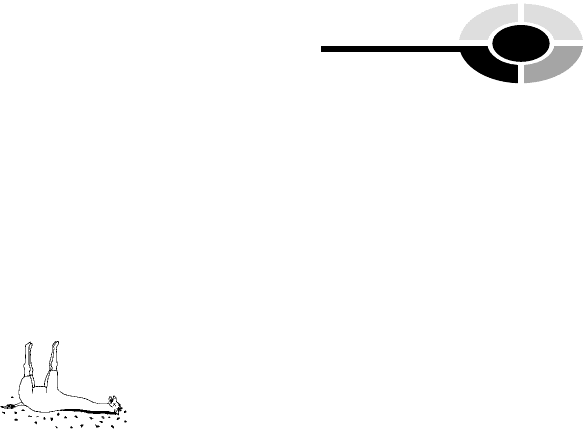
3. ____________________________________________________________
4. ____________________________________________________________
5. ____________________________________________________________
The Dead Giraffe DISORDER TABLE for Chapter 18
(Key Text Facts About Biological Disorder Within An Organism)
1. ____________________________________________________________
2. ____________________________________________________________
CHAPTER 18 The Respiratory System 327
[13:27 13/6/03 N:/4058 LAYMAN.751/4058-Alltext.3d] Ref: 4058 Layman: Biology Demystified All-text Page: 327 1-388
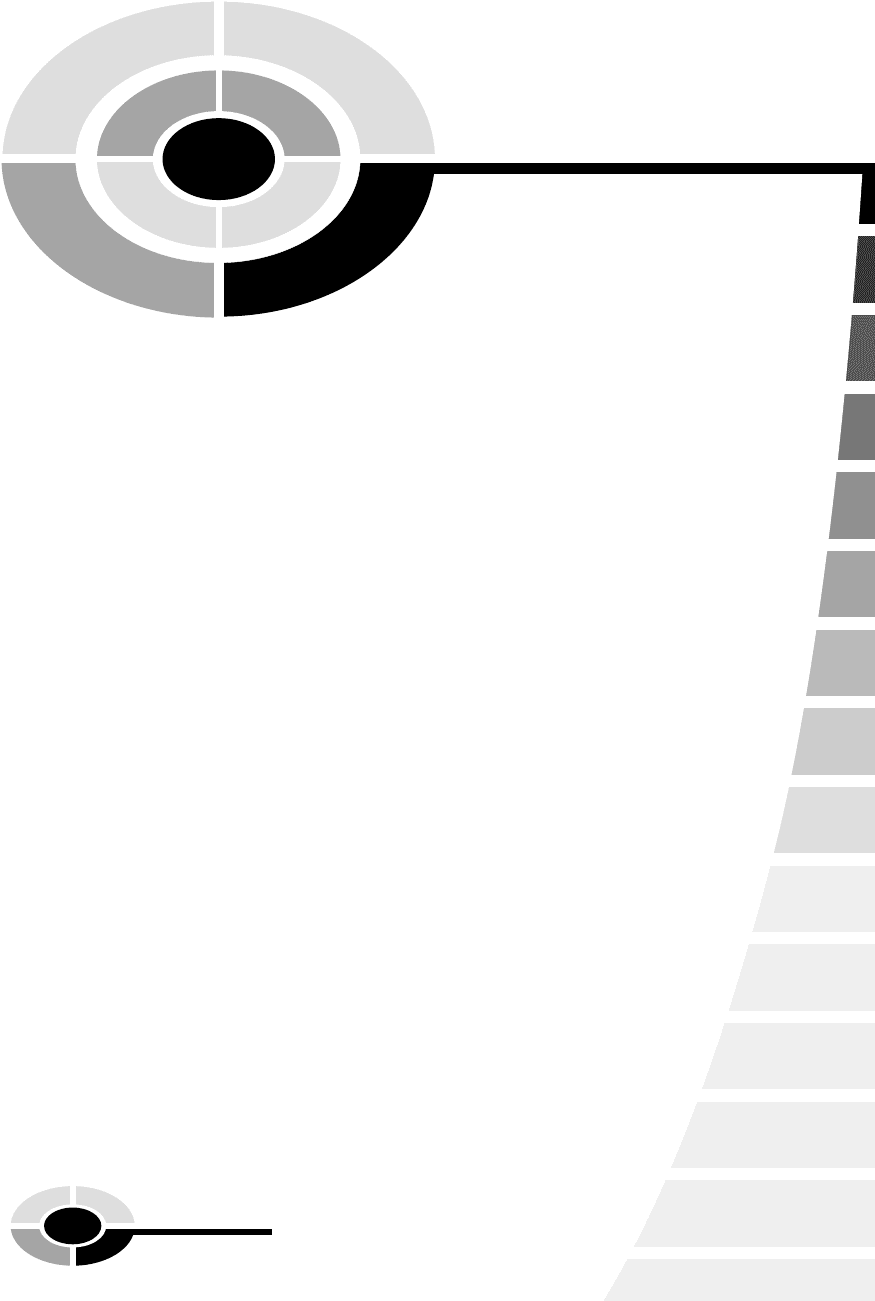
[13:27 13/6/03 N:/4058 LAYMAN.751/4058-Alltext.3d] Ref: 4058 Layman: Biology Demystified All-text Page: 328 1-388
328
CHAPTER
19
‘‘Getting the
Goodies’’: Nutrition
and the Digestive
System
Chapter 18 spoke of the ‘‘Breath of Life.’’ By this, of course, we meant the
respiratory system, and how it operates to take in life-giving oxygen and get
rid of CO
2
and body acid before they accumulate to dangerous levels.
Now we will look at another life-giving process – digestion – and its asso-
ciation with nutrition. Nutrition is the ‘‘process of nourishing,’’ while nutri-
ents (NEW-tree-unts) are ‘‘nourishing (substances).’’ Such nutrients
(nourishing substances) would include, of course, glucose and other simple
sugars, lipids, and proteins consumed for energy within our diet.
Copyright 2003 by The McGraw-Hill Companies, Inc. Click Here for Terms of Use.
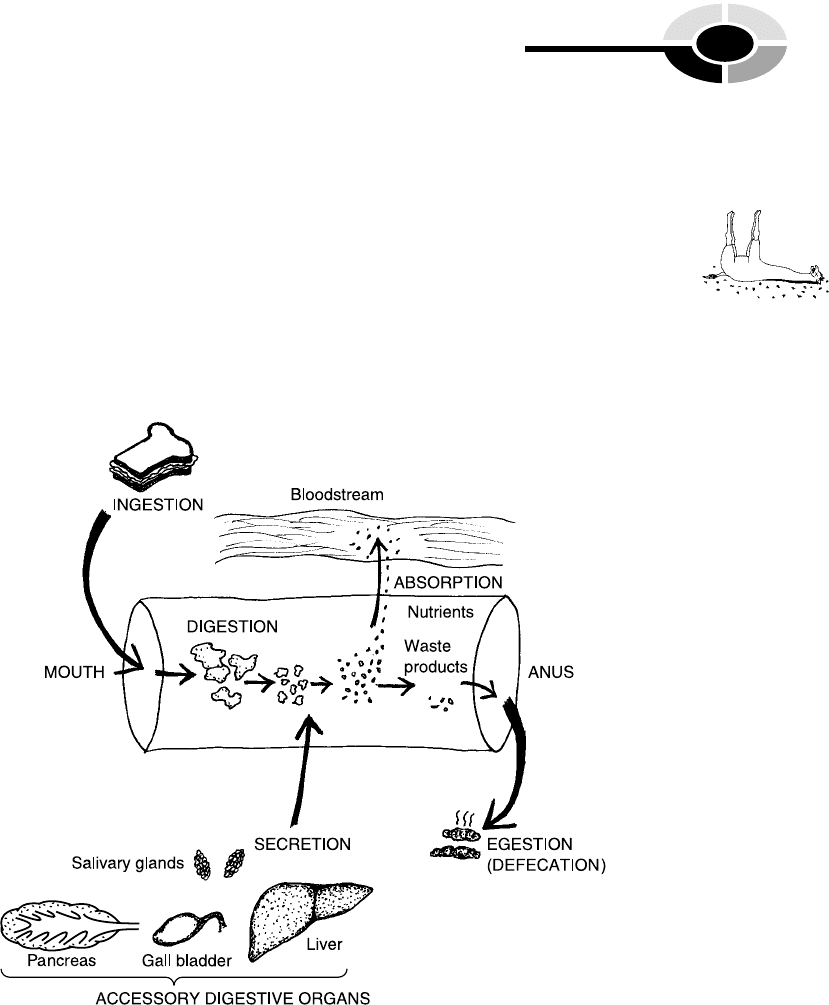
The Digestive Tube and Its Basic Processes
Digestion is literally the ‘‘process of separating or dividing (something)
apart.’’ Formally speaking, digestion is the chemical and physical breakdown
of food, thereby releasing its contained nutrients. But digestion and its break-
down is not an isolated process. It occurs along with many other related
processes, and in the same anatomic location – within the digestive tube
(Figure 19.1). The digestive tube is a tube that extends from the mouth
(oral cavity) to the anus (AY-nus), the small, muscular ‘‘ring’’ through
which one defecates.
INGESTION AND EGESTION
Of the major processes associated with the digestive tube, ingestion (in-JES-
chun) is the first, while egestion (ee-JES-chun) is the last. Ingestion is the
CHAPTER 19 Nutrition/Digestive System 329
[13:27 13/6/03 N:/4058 LAYMAN.751/4058-Alltext.3d] Ref: 4058 Layman: Biology Demystified All-text Page: 329 1-388
Fig. 19.1 The digestive tube and its general functions.
1, Disorder

‘‘process of carrying (food) into’’ (in-) the digestive tube, while egestion is the
‘‘process of carrying (feces) out’’ (e-).
DIGESTION AND ABSORPTION
Absorption is the ‘‘process of swallowing (something) up.’’ In reality, absorp-
tion is a different process from the actual one of swallowing. Swallowing is
the movement of food from the oral cavity, down into the pharynx (throat),
and then into the esophagus (eh-SAHF-uh-gus) or ‘‘gullet,’’ the muscular tube
leading into the stomach.
Absorption is the movement of digested nutrients from the interior of the
digestive tube, into the bloodstream. But we must remember that, quite often,
the food we ingest consists of large chunks of food, far too big to be
absorbed. (Picture a ham sandwich, with protein molecules in the ham and
starch or carbohydrate molecules in the bread.)
Just because a particular foodstuff happens to be ingested through the
mouth, does not necessarily mean that it can be digested (broken down)
into smaller nutrients and absorbed. This digestive process is somewhat
dependent upon the particular kind of stomach the food is entering, and
the various digestive enzymes it may contain.
SECRETION AND DEFECATION
Digestion is often helped by the results of secretion – the release of various
products from accessory digestive organs that are added to the digestive tube
contents. The accessory digestive organs are organs attached to the sides of
the digestive tube, but through which no food or feces actually passes. In
humans, the accessory digestive organs include the salivary (SAH-lih-vair-ee)
glands, pancreas, liver, and gall bladder. These organs all add small quantities
of various secretions to the digestive tube, which help in its process of break-
ing down big chunks of food into smaller molecules of nutrients.
Egestion is also called defecation (deh-feh-KAY-shun), the excretion of
unusable waste products within the feces or excrement.
SUMMARY
The five basic processes involving the digestive tube are thus ingestion, diges-
tion, secretion, absorption, and egestion (defecation).
[13:27 13/6/03 N:/4058 LAYMAN.751/4058-Alltext.3d] Ref: 4058 Layman: Biology Demystified All-text Page: 330 1-388
PART 4 Anatomy and Physiology of Animals
330
1, Order
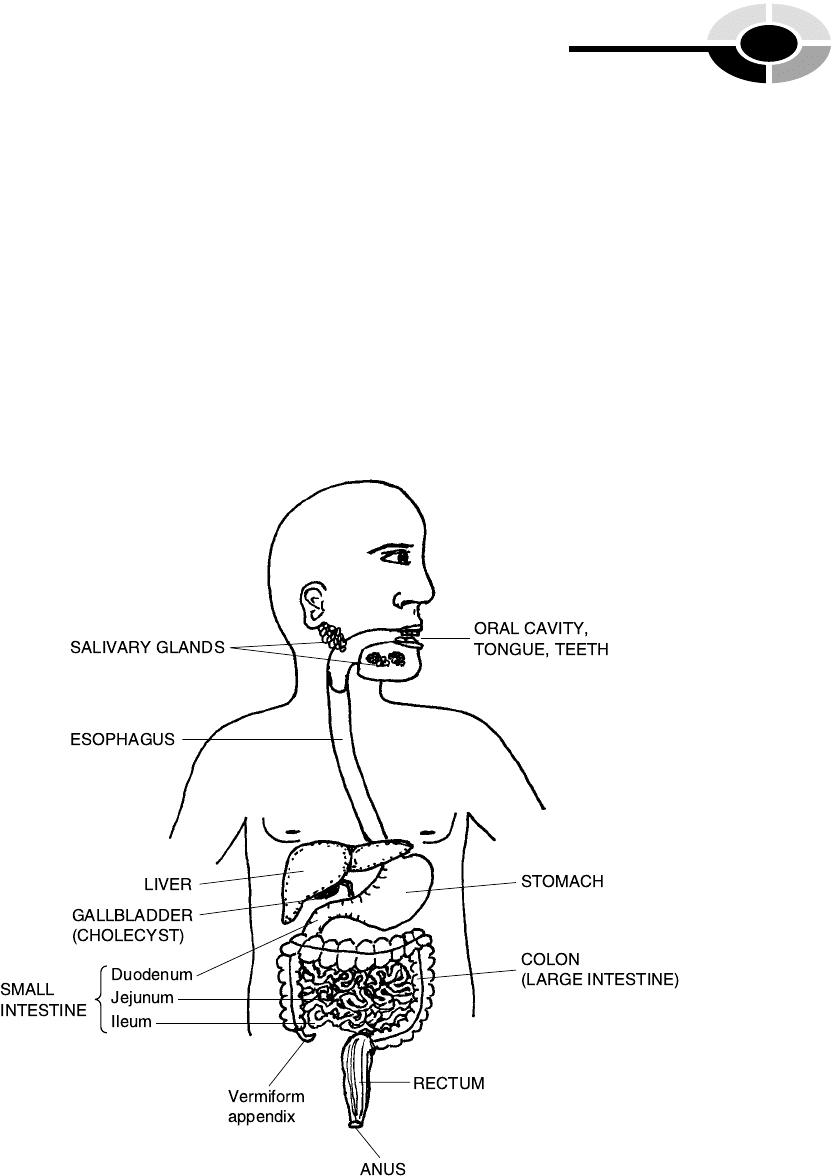
The Digestive Tube (Alimentary Canal) in
Mammals
The digestive tube is alternately called the alimentary (al-uh-MEN-tur-ee)
tract. The reason, of course, is that the digestive tube has many of its
major functions ‘‘related to’’ (-ary) ‘‘nourishing’’ (aliment) the rest of the
body. Let us now, therefore, examine the parts of the human digestive
tube in sequence, along with their related functions. (Start looking at
Figure 19.2). And in so doing, we shall also be learning about the digestive
tube in other mammals.
CHAPTER 19 Nutrition/Digestive System 331
[13:27 13/6/03 N:/4058 LAYMAN.751/4058-Alltext.3d] Ref: 4058 Layman: Biology Demystified All-text Page: 331 1-388
Fig. 19.2 Major features of the human digestive tube.
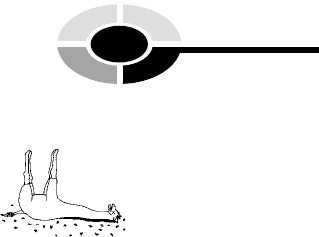
THE ORAL CAVITY, PHARYNX, AND ESOPHAGUS
Food ingested by a human (or other mammal) immediately enters the mouth
(oral cavity) where physical digestion of all three major types of foodstuffs
(carbohydrates, lipids, and proteins) begins. Physical digestion is just the
mechanical breaking apart of ingested food, using the teeth, lips, and gums.
In humans, chemical digestion of carbohydrates also begins within the oral
cavity. This is due to the presence of ‘‘spit’’ or saliva (sah-LIE-vah), secreted
into the mouth by the salivary glands. The saliva contains various digestive
enzymes, such as salivary amylase (AM-ih-lace), or ‘‘starch’’ (amyl) ‘‘split-
ter.’’ Salivary amylase begins the chemical digestion (breakdown) of complex
carbohydrates, such as starch, into double-sugars. [Study suggestion: Eat a
plain saltine cracker. At first, it is quite dull, reflecting its complex starch
content. But as you chew it and mix it with your saliva, notice that it begins
to taste sweet. To what specific chemical should you give credit for this
dramatic change?]
By the time a person is done chewing food and mixing it with saliva, the
general result is a food bolus (BOH-lus). A food bolus is a soft ‘‘ball’’ (bol)of
partially digested food.
When done chewing, the person uses the tongue and flips the food bolus
into the back of the oropharynx (portion of the throat behind the mouth).
The bolus pushes the epiglottis shut, then slides down into the esophagus.
The upper portion of the esophagus is lined by voluntary striated (cross-
striped) muscle. Hence, the first part of swallowing is voluntary. (‘‘So, why
did I just gulp down that piece of delicious apple?’’ you might well ask
yourself. ‘‘Because I darn well wanted to, that’s why!’’)
However, the lower 2/3 of the esophagus is lined by smooth, involuntary
muscle. This means that the latter part of swallowing is not under our con-
scious control. Therefore, once a swallowed food bolus has entered the lower
esophagus, you just have to let it go down into your stomach! (‘‘Oh, oh!’’ you
might suddenly question yourself. ‘‘Didn’t I just see half a worm in that
chunk of apple?’’ Too late! You’ve already swallowed it! You can’t back
out, now!)
THE STOMACH AND ITS ADAPTATIONS
In humans, the stomach is a capital J-shaped pouch that acts as a temporary
storage place for ingested food. The body is the large central area of the
stomach, while the pylorus (pie-LOR-us) or ‘‘gatekeeper’’ is a small room
at the far end of the stomach.
[13:27 13/6/03 N:/4058 LAYMAN.751/4058-Alltext.3d] Ref: 4058 Layman: Biology Demystified All-text Page: 332 1-388
PART 4 Anatomy and Physiology of Animals
332
2, Disorder

The epithelial cells lining the ‘‘stomach’’ (gastr) secrete the gastric (GAS-
trick) juice. The gastric juice is especially rich in hydrochloric (HIGH-droh-
klor-ik) acid, abbreviated as HCl, and pepsin (PEP-sin). Being an extremely
strong acid, HCl breaks down rapidly and donates many H
þ
ions, making it
highly reactive and corrosive. Thus, hydrochloric acid begins the chemical
digestion of lipids and proteins, as well as continuing the digestion of carbo-
hydrates. Pepsin is an enzyme that helps break down proteins, as well.
Due to the action of the gastric juice, the food bolus from the esophagus is
now changed into chyme (KIGHM). The chyme is a thick, soupy mass of
partially digested material. Since it is almost a liquid, chyme is like a ‘‘juice’’
(chym) that leaves the stomach through a muscular ring called the pyloric
(pie-LOR-ik) sphincter.
‘‘If the stomach is full of so much HCl, then why doesn’t it digest itself ?’’
Part of the answer is that the stomach secretes a highly alkaline (basic) layer
of mucus, a protective ‘‘slime’’ (muc) that coats the lining and neutralizes acid
that contacts it.
There is one type of foodstuff that HCl and pepsin hardly touch, however.
That foodstuff is cellulose (SELL-yuh-lohs). Cellulose is a ‘‘carbohydrate’’
(-ose) composed of the walls of many ‘‘little cells’’ (cellul) found in plants.
Wood, cotton, and grass, for instance, are largely made up of cellulose. ‘‘Why
don’t we just send the kids out in the backyard to graze on our grass?’’ a
sarcastic father might jokingly ask. ‘‘After all, then we wouldn’t have to mow
it, and they’d get big as cows!’’
A comparison to the anatomic features of the cow stomach may help
explain why this dad is really off the mark! As Figure 19.3 reveals, the cow
stomach consists of four different chambers. These chambers are called the
rumen (ROO-men), reticulum, omasum (oh-MAY-sum), and abomasum (ab-
uh-MAY-sum). Because the first chamber, the rumen, is so important, it
serves as the foundation for the name of the entire group of herbivores
(plant-eating mammals) to which cows, deer, goats, and sheep belong. This
group is called the ruminants (REW-muh-nunts) – animals that are ‘‘chewers
of cud.’’
Cud represents a mouthful of food that has been swallowed and then
brought back up into the mouth from the rumen (first stomach chamber)
of a ruminant. The cud is then given a slow, thorough, second chewing before
it is swallowed, again. But simple re-chewing isn’t good enough, by itself.
This is because cows, like humans, don’t produce enzymes capable of che-
mically digesting plant cellulose (as found in grass). To get around this
problem, there are special bacteria and protists (Chapter 7) living in the
first two stomach chambers, the rumen and reticulum. Now, the micro-
organisms within these chambers do have enzymes that digest cellulose in
CHAPTER 19 Nutrition/Digestive System 333
[13:27 13/6/03 N:/4058 LAYMAN.751/4058-Alltext.3d] Ref: 4058 Layman: Biology Demystified All-text Page: 333 1-388
3, Disorder
1, Web
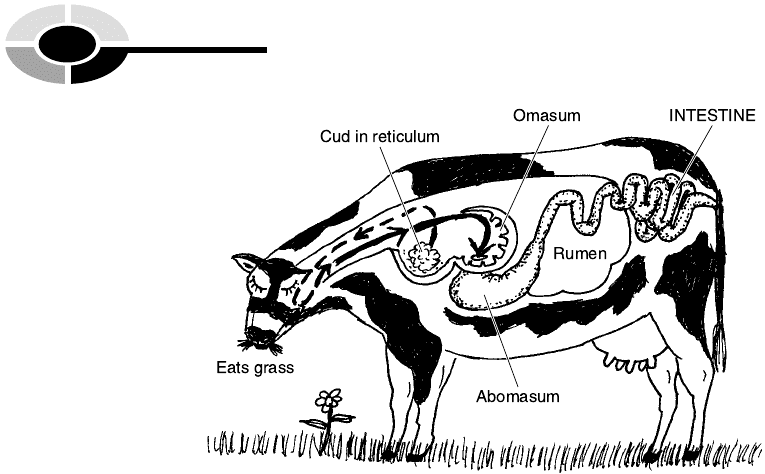
grass and break it down into simple sugars that the cow’s stomach can
further handle, then absorb. The repeated chewing of cud containing millions
of these micro-organisms simply crunches up the cellulose plant walls,
thereby allowing the enzymes to digest them even more efficiently.
THE WONDROUS SMALL INTESTINE
Within humans, the small intestine is a small-diameter, extensively folded
tube that averages about 20 feet (6 meters) in length. We have called this
the wondrous small intestine, because of all the wonderful and amazing feats
of digestion and absorption that occur within its walls.
The first segment of the small intestine is called the duodenum (dew-AH-
den-um), which comes from Medieval Latin for ‘‘presence of 12.’’ Thus, the
name, duodenum, reflects the fact that ancient anatomists measured its
length as equal to about 12 fingers, placed side-by-side. A close look at
Figure 19.4 also shows how critical the duodenum is as a common meeting
point for chyme and various digestive secretions.
The duodenum receives chyme from the pylorus of the stomach, and
secretions from the liver, gall bladder, and pancreas, as well. The liver is a
large, brown, many-lobed organ that produces and secretes bile, as well as
many other useful substances. Bile is a brownish-green detergent substance
that emulsifies (ih-MUL-sih-feyes) fat within the small intestine.
Emulsification (ih-mul-suh-fuh-KAY-shun) is literally the ‘‘process of ’’
(-tion) ‘‘milking out’’ (emulsif) one non-mixable fluid substance from another
[13:27 13/6/03 N:/4058 LAYMAN.751/4058-Alltext.3d] Ref: 4058 Layman: Biology Demystified All-text Page: 334 1-388
PART 4 Anatomy and Physiology of Animals
334
Fig. 19.3 The four stomach chambers of the cud-chewing cow.

one. Consider, in this case, the large globules of partially digested fat that do
not mix very well with the soupy chyme entering the duodenum from the
stomach. Bile from the liver acts to emulsify the large fat globules, breaking
them apart (or, in a sense, ‘‘milking them out’’ of the rest of the chyme). As a
result, a separate foam of tiny fat droplets is created within the small intes-
tine. [Study suggestion: Pour some liquid detergent onto a bunch of greasy
plates, and then observe what happens. In what way does this liquid deter-
gent act somewhat like bile?]
Bile is secreted continuously, day and night, into the right and left hepatic
(heh-PAT-ik) or ‘‘liver’’ ducts. These ducts carry the bile into the cystic (SIS-
tic) duct. Cyst means ‘‘bladder’’ or ‘‘sac,’’ while chole (KOH-lee) is Latin for
‘‘bile or gall.’’ Hence, the compound word, cholecyst (KOH-luh-sist), trans-
lates into English as ‘‘gall bladder’’ or ‘‘bile sac.’’
The cholecyst (gall bladder) is a muscular-walled sac that receives the bile
from the liver and stores it temporarily. When the duodenum becomes swol-
len with fatty chyme, a hormone is released that stimulates the walls of the
gall bladder to contract. A load of bile is squirted out of the cholecyst, much
like a slug of brownish-green pea soup or gravy being squeezed out of a
rubber balloon.
The bile squirts into the cystic duct, and then into the common bile duct,
which carries it the rest of the way down into the duodenum. Here, then, the
emulsification of fat takes place.
As shown in Figure 19.4, the pancreatic (pan-kree-AT-ik) duct extends
from the pancreas and merges with the base of the common bile duct. The
pancreatic duct is the main passageway for the pancreatic juice. Surrounding
both of them at their point of union is the hepatopancreatic (heh-PAT-oh-
pan-kree-AT-ik) sphincter (SFINK-ter). The hepatopancreatic sphincter is a
ring of smooth muscle that regulates the emptying of both the common bile
duct (the hepatic or ‘‘liver’’ portion) and the pancreatic duct into the small
intestine. When this sphincter (muscular ring) relaxes, bile and pancreatic
juice flow through the duodenal (dew-AH-deh-nal) papilla (pah-PIL-lah).
The duodenal papilla is a ‘‘little nipple or pimple’’ (papill) -like projection
with a hole in its center. Bile from the liver and pancreatic juice from the
exocrine gland portion of the pancreas (Chapter 15) drip into the duodenum
through the hole in the duodenal papilla.
The pancreatic juice contains sodium bicarbonate (buy-CAR-buh-nayt),
symbolized chemically as NaHCO
3
, as well as a variety of digestive enzymes.
These enzymes include amylases (starch-splitters), lipases (LIE-pay-sez) or
‘‘fat-splitters,’’ and proteases (PROH-tee-ay-sez) or ‘‘protein-splitters.’’ The
lipases, for example, complete the chemical digestion of fat or lipids, after
they have been emulsified by bile into a fatty foam. The resulting products,
CHAPTER 19 Nutrition/Digestive System 335
[13:27 13/6/03 N:/4058 LAYMAN.751/4058-Alltext.3d] Ref: 4058 Layman: Biology Demystified All-text Page: 335 1-388
4, Disorder
5, Disorder
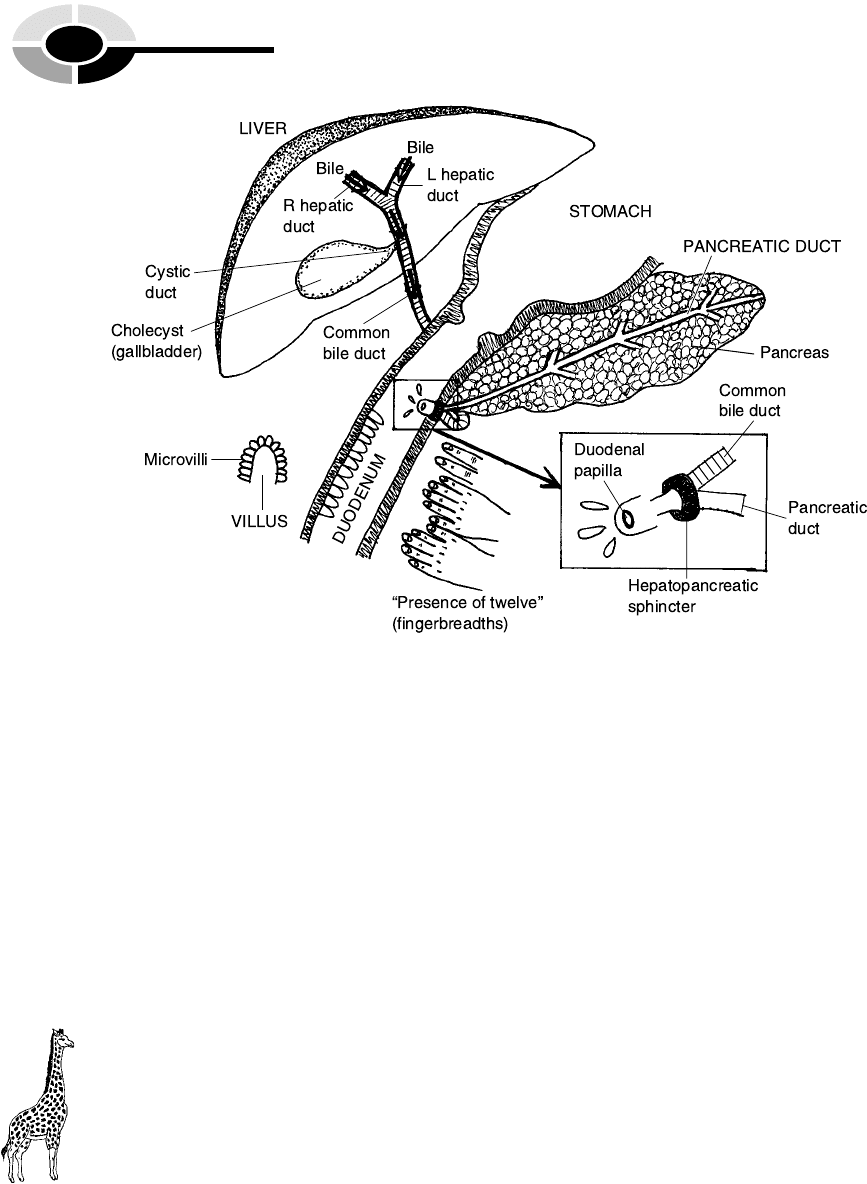
such as fatty acids and the substance, glycerol (GLIH-sir-ahl), are then
absorbed across the walls of the small intestine, and into the bloodstream.
Similarly, the proteases continue the chemical breakdown of proteins into
amino acids, which are also absorbed into the bloodstream. And the amy-
lases in the small intestine generally finish the chemical breakdown of carbo-
hydrates into simple sugars such as glucose, which are then absorbed.
Reflecting its critical role in the absorption of nutrients, there are several
important modifications to the mucosa (mew-KOH-sah), the ‘‘mucous’’
(mucos) membrane lining the small intestine. The mucosa of the duodenum,
jejunum, and ileum is thrown into thousands of villi (VIL-ee). Review of
Figure 19.4 shows that each single villus (VIL-us) is literally named for its
resemblance to a little bump or curved ‘‘tuft of hair’’ (vill). The surface of
each villus, in turn, is covered with dozens of microvilli (MY-kroh-vil-ee). The
microvilli are little bumps upon each villus, like ‘‘tiny tufts of hair.’’ The
numerous villi and microvilli, by throwing the mucosa up into hundreds of
tiny bumps, vastly increases the amount of surface area available for absorp-
tion. As a result, the absorption of nutrients into the bloodstream from the
small intestine is extremely efficient.
[13:27 13/6/03 N:/4058 LAYMAN.751/4058-Alltext.3d] Ref: 4058 Layman: Biology Demystified All-text Page: 336 1-388
PART 4 Anatomy and Physiology of Animals
336
Fig. 19.4 The duodenum and its friendly neighbors.
2, Order
